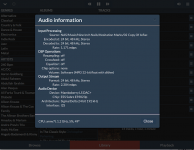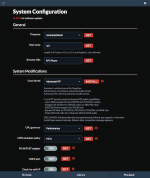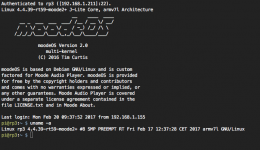In relation to slow USB speed over the network copying files on a hard drive connected to the raspberry pi:
I have the same problem. Speed is 65kb/s max. The 1,5TB USB disk is ntsf formatted and preloaded with 800GB of data. Changing from sync to async speeds up the process to 2MB/s when I want to add a new disk. Unfortunately I'm not able to see all previous data!
Does this mean I need to copy everything again with the rate of 2MB/s? This would be very time consuming...
Hi,
Try changing sync to async for your particular USB disks file system in the config file below, then reboot.
/etc/udisks-glue.conf
-Tim
I have the same problem. Speed is 65kb/s max. The 1,5TB USB disk is ntsf formatted and preloaded with 800GB of data. Changing from sync to async speeds up the process to 2MB/s when I want to add a new disk. Unfortunately I'm not able to see all previous data!
Does this mean I need to copy everything again with the rate of 2MB/s? This would be very time consuming...
OK, that makes sense, but I'm still not sure why 24-bit audio (including 24-bit FLACs) is output at 32-bit.
The Digi+ is listed as having a "S/PDIF transceiver 24 bit 192 kHz" architecture, doesn't that imply 24-bit capability?
Thanks for your help!
Hi,
Hard to say. The attached screen shot from one of my systems shows 24 bit FLAC through the audio pipeline. I used XLD to convert my ALAC collection to FLAC and the source track shown in the screen shot was originally 24/48 Redbook CD.
-Tim
Attachments
I finally built the MoodeCase project I had in hand, using the Collybia MamboBerry LS DAC+ and a 5v iPower. Superb sound running Moode 3.1 as a UPnP renderer at a very low cost:
An externally hosted image should be here but it was not working when we last tested it.
Nice!
Hi,
Next release of Moode will raise the bar for audio quality and include a fully integrated REAL-TIME Advanced Audio Kernel supporting the latest I2S drivers from Allo (Piano | Boss) and many other nice features and improvements.
Get ready for SMP PREEMPT RT 🙂
-Tim
Next release of Moode will raise the bar for audio quality and include a fully integrated REAL-TIME Advanced Audio Kernel supporting the latest I2S drivers from Allo (Piano | Boss) and many other nice features and improvements.
Get ready for SMP PREEMPT RT 🙂
-Tim
Attachments
Dear Friend,
Sorry to be so stupid, but I´m not being able to even install moode. I had Rune audio running and I removed my SD card, formated it, flashed moode disk image and inserter on Rasp Pi 3, but it continues opening Rune Audio. What should I do to install moode ?
tks and brgds
Sorry to be so stupid, but I´m not being able to even install moode. I had Rune audio running and I removed my SD card, formated it, flashed moode disk image and inserter on Rasp Pi 3, but it continues opening Rune Audio. What should I do to install moode ?
tks and brgds
Dear Friend,
Sorry to be so stupid, but I´m not being able to even install moode. I had Rune audio running and I removed my SD card, formated it, flashed moode disk image and inserter on Rasp Pi 3, but it continues opening Rune Audio. What should I do to install moode ?
tks and brgds
Follow the readme exactly, you will have a working Moode system. http://moodeaudio.org/docs/readme.txt
A quick list of tasks: download the image from moodeaudio.org, extract it from the zip, use a flash image writer, like Windows 32 Disk Imager, put the SD in, write the image, place in Pi, boot.
The fact you still booted Rune, says you didn't reflash the SD.
Last edited:
I finally built the MoodeCase project I had in hand, using the Collybia MamboBerry LS DAC+ and a 5v iPower. Superb sound running Moode 3.1 as a UPnP renderer at a very low cost:
An externally hosted image should be here but it was not working when we last tested it.
Looking nice! What would be a good alternative to the DAC. Will the Audiophonics 9023 TCXO be almost equal? What power supply did you use?
Hi,
Next release of Moode will raise the bar for audio quality and include a fully integrated REAL-TIME Advanced Audio Kernel supporting the latest I2S drivers from Allo (Piano | Boss) and many other nice features and improvements.
Get ready for SMP PREEMPT RT 🙂
-Tim
Great news!
That pic is so big half of it is showing up on my neighbours monitor 🙂
PS it's ok once you login
PS it's ok once you login
Has Moode the ability to display trackinfo and coverart on an attached 2.5-4 inch display?
Moode is designed as a headless system so no support is given for displays it is left for the user. However Moode does provide the ability to execute python scripts and metadata file of the current track which you can use to update displays.
I am running Moode 2.7 and want to upgrade to 3.1. using the " check for software update" in the GUI does not work, it says " Moode software is up to date"
I have been tweaking a lot getting it up and running on my dac so I am reluctant to do a fresh upgrade via PC.
Is there another way to upgrade without compromising all the settings in my current version?
I have been tweaking a lot getting it up and running on my dac so I am reluctant to do a fresh upgrade via PC.
Is there another way to upgrade without compromising all the settings in my current version?
Looking nice! What would be a good alternative to the DAC. Will the Audiophonics 9023 TCXO be almost equal? What power supply did you use?
I used a 5v iPower to directly supply the DAC card, and through it the RPi3 board as well. You can also remove a jumper on the DAC board and power each piece separately if you choose, and I may try that with the UpTone LPS-1 borrowed from my other system. In that scenario the LPS-1 would power the DAC card and the iPower would supply the RPi3.
I don't have any direct feedback regarding the Audiophonics DAC card other than to say I considered it, and I believe it uses the same ESS Sabre chip as the Mambo. As always it will be all about the actual implementation as to how that sounds, the Mambo board is using very high quality caps and resistors and pays close attention to the power supply aspect. That Audiophonics V3 board does look nice however, but I didn't like that it runs on 6/7 volts and wouldn't work with my existing power supplies.
Last edited:
I am running Moode 2.7 and want to upgrade to 3.1. using the " check for software update" in the GUI does not work, it says " Moode software is up to date"
I have been tweaking a lot getting it up and running on my dac so I am reluctant to do a fresh upgrade via PC.
Is there another way to upgrade without compromising all the settings in my current version?
Hi,
Moode 3.1 is image only due to change in root partition size.
-Tim
CM6631A problem
Hello everyone,
I am really very new at raspberry and moode. I bought a pi3 last week and I am running it with 2 amp apple adaptor.
I have 3 different kinds of dac, chinese maverick, korean Audiotrack Prodigy Cube and DIY DAC using USB in section with CM6631A. Well I try all these DACs and first 2 recognised by Moode without any problem but couldn't sucseed CM6631A.
I tried many things on configure menu but NO.
From menu, seems pi3 find the dac but when I play, no any sound.
Do you have any tips abt this problem ?
Thanks in advance
Hello everyone,
I am really very new at raspberry and moode. I bought a pi3 last week and I am running it with 2 amp apple adaptor.
I have 3 different kinds of dac, chinese maverick, korean Audiotrack Prodigy Cube and DIY DAC using USB in section with CM6631A. Well I try all these DACs and first 2 recognised by Moode without any problem but couldn't sucseed CM6631A.
I tried many things on configure menu but NO.
From menu, seems pi3 find the dac but when I play, no any sound.
Do you have any tips abt this problem ?
Thanks in advance
Hi
I just burnt this to SD card to test on a Pi2
Installed fine and planning to get a DAC but when testing using headphones and the pi 3.5mm audio connector the sound is very 'crackly' both for mp3 on local usb and streaming! Any pointers?
I just burnt this to SD card to test on a Pi2
Installed fine and planning to get a DAC but when testing using headphones and the pi 3.5mm audio connector the sound is very 'crackly' both for mp3 on local usb and streaming! Any pointers?
Follow the readme exactly, you will have a working Moode system. http://moodeaudio.org/docs/readme.txt
A quick list of tasks: download the image from moodeaudio.org, extract it from the zip, use a flash image writer, like Windows 32 Disk Imager, put the SD in, write the image, place in Pi, boot.
The fact you still booted Rune, says you didn't reflash the SD.
I've done all these procedures, using Win32 disk imager, and even made a long format on the sd card. All the contents are in the sd card after the image in burned, but I insert this on the Rasp and it just doesn't read it. It shows some letters to log in on Runeaudio and after a few seconds, even if I don't hit any character on the keyboard, it just shows Runeaudio interface... Is it possible to "reset" the raspberry ?
I've done all these procedures, using Win32 disk imager, and even made a long format on the sd card. All the contents are in the sd card after the image in burned, but I insert this on the Rasp and it just doesn't read it. It shows some letters to log in on Runeaudio and after a few seconds, even if I don't hit any character on the keyboard, it just shows Runeaudio interface... Is it possible to "reset" the raspberry ?
I always reformat the SD card before I begin an installation. Use SDFormatter or a similar utility to do that. I have never had a problem.
You need to use a proper OS then use dd to write the image 😉I've done all these procedures, using Win32 disk imager, and even made a long format on the sd card. All the contents are in the sd card after the image in burned, but I insert this on the Rasp and it just doesn't read it. It shows some letters to log in on Runeaudio and after a few seconds, even if I don't hit any character on the keyboard, it just shows Runeaudio interface... Is it possible to "reset" the raspberry ?
I've just installed Sdformatter, made a new format and then burned the image again using the Win32. After doing this, Sd shows all the files but shows used space only about 80mb from total space of 100mb... I'm using Win 10 64bits.
- Home
- Source & Line
- PC Based
- Moode Audio Player for Raspberry Pi


